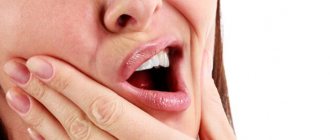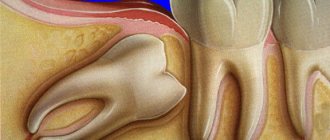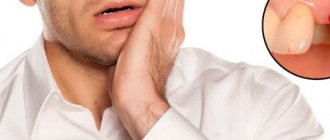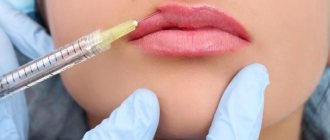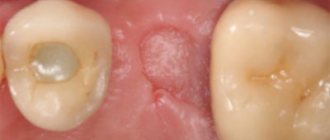Cold (ice pack, cold compress), elevated position of the affected limb and rest during the first day help relieve swelling after a bruise. Apply ointments with anti-edematous and anti-inflammatory effects - Heparin, Lyoton gel, Bruise Off, Troxevasin.
From the second day, physical therapy can be prescribed - magnetic therapy, UHF, then they are supplemented with electrophoresis, diadynamic therapy, ultrasound. For mild bruises, you can use folk remedies - salt, semi-alcohol compress, lotions with wormwood infusion.
In the absence of complications, swelling decreases significantly by the 3rd day, and completely disappears by the end of the week. If the condition worsens and pain and swelling increase, you need to be examined by a traumatologist. A mandatory visit to the emergency room is necessary in case of injury to the head, abdomen, back or chest; a dangerous sign is the inability to move a limb, weakness, or fainting.
How to relieve swelling after a bruise and prevent its development
To relieve swelling after a bruise and prevent its formation during injury, you need to apply cold. It's best to grab an ice pack or frozen food from the freezer. They are wrapped in a towel and held for 15 minutes, then removed and after half an hour the procedure is repeated. If there is no ice, use a wet towel or a heating pad filled with cold water.
If there was a bruise to a limb, then it is provided with rest and an elevated position. If movement is necessary, an elastic bandage is applied to the affected joint; it prevents active blood flow. A tight bandage inhibits the development of edema, but it can be used for no more than half an hour, as blood circulation is impaired.
If the face, head, or upper body are injured, a high pillow is placed while resting to ensure blood flow. If the injury was in the area of the coccyx, sacrum, or lower back, then you need to lie on your side or stomach. Abrasions or wounds are washed and treated with hydrogen peroxide before applying ice. The damaged skin is smeared with iodine or brilliant green and covered with a bandage, fixed with a bandage.
Injury
5289 12 August
IMPORTANT!
The information in this section cannot be used for self-diagnosis and self-treatment.
In case of pain or other exacerbation of the disease, diagnostic tests should be prescribed only by the attending physician. To make a diagnosis and properly prescribe treatment, you should contact your doctor. Bruise: causes, symptoms, diagnosis and treatment methods.
Definition
Bruise is a closed mechanical damage to internal tissues or organs without significant disruption of their structure. Bruises are characterized by suddenness, speed and short duration of action of the traumatic factor. Bruises are mostly local in nature. The most vulnerable are the dermis and the vessels located under it, which leads to the formation of hematomas and edema. As a result of a severe bruise, internal organs may be injured. The severity of the process is determined by the type of damaged tissue or organ that is affected by the traumatic agent (skin, subcutaneous tissue, muscles, parenchymal or hollow organs, brain or spinal cord, etc.).
In cases where the damage is severe, multiple ruptures of small vessels occur, followed by hemorrhage and dysfunction of the organ.
Causes of bruises
A bruise is considered the most common type of household injury and usually occurs when falling or hitting hard objects. In children of the first years of life, household and play injuries, bruises of the soft tissues of the face and neck predominate. At older ages, the main ones are considered to be transport, sports and street injuries.
Lung contusion and/or heart contusion as a result of mechanical impact on the chest is a potentially dangerous injury - the vast majority of victims are drivers who hit their chest against the steering column of a car.
Contusion of superficial soft tissues is always accompanied by swelling of the injury site as a result of soaking of the skin with lymph, blood and local aseptic inflammation. The severity of edema depends on the area of damage to the subcutaneous tissue at the site of the injury. For example, in the area of the cranial vault, due to the thin layer of subcutaneous fatty tissue, the swelling is insignificant, while even mild bruises of the face are accompanied by severe swelling.
A concussion can develop as a result of a head injury.
Severe deep bleeding often leads to additional injury to adjacent tissues as a result of their compression, which is accompanied by a gradual increase in pain and dysfunction of the injured organ.
Often, abrasions and shallow wounds are observed at the site of injury, which serve as entry points for infectious agents.
Classification of the disease
Bruises vary in severity:
- the first is a slight injury without violating the integrity of the skin or with minor scratches and abrasions, practically painless, self-healing over several days;
- the second is a muscle bruise, accompanied by severe pain, swelling and bruising;
- third - as a result of a bruise, ligaments and tendons can be damaged;
- fourth - bruise of internal organs with severe swelling and pain, with the possibility of disruption of the damaged organs.
Symptoms of a bruise
The main signs of a bruise are pain in the damaged area, hemorrhage due to ruptured capillaries, the formation of hematoma and edema.
Hemorrhage at the site of the bruise appears as a blue-purple spot, the color of which gradually changes to greenish and yellow. Depending on the location of the injury, bruising and swelling may appear immediately, as occurs in the case of damage to the subcutaneous tissue and upper layers of the skin. In the case of bruises of deep tissues, a hematoma forms after several hours or even days.
Soft tissue injuries are accompanied by pain of varying intensity. Thus, with bruises of large nerves and their endings, the pain is always sharp, shooting. With bruises of the torso and limbs, tense hematomas with bursting pain, sometimes with superficial numbness, can occur.
The swelling that accompanies a bruise reduces the mobility of injured tissues, creating discomfort during movement or rotation of the body (for example, when the ribs are bruised). The victim experiences the most severe pain immediately after a soft tissue injury, and after a couple of hours it subsides. When pressed, the pain increases.
When a joint is bruised several hours after the injury, its volume increases, function is impaired, and pain intensifies (especially when moving).
Severe pain occurs when the periosteum, external genitalia, or large nerve trunks are bruised.
The symptoms of a bruise and a closed fracture are very similar: severe pain, swelling, limited mobility. But if in the case of a bruise the pain subsides within 2-3 hours, then with a fracture it, on the contrary, can intensify.
The general condition of patients with limited, superficial bruises usually does not suffer. But with multiple bruises of the body, large or festering hematomas, hemarthrosis (bleeding into the joint cavity), fever with a temperature of up to 38 ° C and higher is possible, caused by the absorption of blood breakdown products.
Symptoms of a lung contusion include tenderness and pain in the chest, ribs, and in some cases, shortness of breath. Other physical signs may be observed due to concomitant injuries.
Diagnosis of bruise
Basic diagnostic methods:
- chest x-ray;
How to remove swelling from the face after a blow with the help of medicine
If your cheek is swollen after a blow, applying ointments that thin the blood and facilitate venous and lymphatic drainage will help relieve the swelling. They are used on the first day along with cold (in the intervals between applying ice) 3-4 times a day. Apply a thin layer to the area of swelling:
- Heparin ointment - relieves swelling and inflammatory reaction, penetrates deeply into the skin, helps resolve hemorrhage;
- Bruise Off - contains an extract from leech and pentoxifylline, which activates local blood circulation, the drug stimulates the movement of lymph, has a toning effect that masks traces of a bruise;
- Lyoton gel - heparin in the gel quickly reduces swelling, helps eliminate pain and inflammation;
- Troxevasin gel - troxerutin reduces vascular permeability, which prevents facial swelling, increases the tone of the venous walls and accelerates the outflow of blood from the site of injury;
- Reparil gel - has a pronounced analgesic and anti-inflammatory effect, relieves swelling by inhibiting the transition of fluid into tissue, improves microcirculation.
For severe swelling, diuretic tablets (Furosemide, Hypothiazide) are used in the first two days, anti-inflammatory and painkillers (Diclofenac, Ibuprofen), but they are of auxiliary value. Post-traumatic edema is associated with tissue damage and goes away only after tissue recovery.
If the integrity of the skin is compromised, it is recommended to apply Rescue or Ambulance balm; if there is a risk of suppuration, use Levomekol ointment.
How quickly can you get rid of bruises?
So, if you don’t have as much time as it takes for a black eye to go away on its own, you can use some secrets to eliminate the hematoma as quickly as possible. Here is a list of the most effective ones, starting from those from which the effect occurs as quickly as possible:
- Cosmetic disguise. Of course, makeup does not remove painful sensations when touched, but modern products, when applied correctly, will help remove blue discoloration and even “hide” puffiness;
- Applying ice. If you use any cold object in the first minutes after the blow is struck, the appearance of a bruise can even be completely avoided. In any case, holding in the damaged area will take at least 20 minutes to achieve the desired effect. If necessary, the manipulation can be repeated after 3-5 minutes. The product should be applied not to the lower eyelid, but to the cheek in the area of the bruise.
- Medicines: ointments, gels. It is recommended to start using them no earlier than 2 days after the incident and only if there are no abrasions or open wounds on the skin. 5-7 days after use, the hematoma significantly decreases in size and goes away.
- Traditional methods. They don’t help everyone and not right away, but it’s worth a try. Compresses made from medicinal herbs should not be applied to scratches, so as not to provoke an unpleasant burning sensation or renewed bleeding from the wound. This method will bear fruit after a week of stable use.
Physiotherapy
Magnetotherapy
Physiotherapeutic procedures are prescribed from 2-3 days to speed up blood circulation, resolve bruises and swelling. They help heal damaged tissues and reduce residual effects after a bruise. Apply:
- magnetic therapy - treatment with an alternating magnetic field reduces pain and swelling, improves tissue nutrition and blood flow, can be used on damaged skin starting from the second day;
- UHF - ultra-high-frequency waves have a deep warming and absorbing effect, indicated in the presence of seals;
- electrophoresis of drugs (Heparin, Iodine, Lidaza) helps quickly relieve swelling and eliminate skin hemorrhages, prevents post-traumatic inflammation;
- diadynamic therapy using a gentle method - currents with different wave amplitudes have a massaging effect and activate blood flow;
- ultrasound – ultrasonic waves stimulate blood movement, accelerate the restoration of damaged tissues, can be used with ointments (phonophoresis).
After relieving pain and inflammation, manual massage is used to improve the movement of blood and lymph. It is carried out not at the site of injury, but along the path of venous blood and lymphatic fluid. For example, for swelling of the face, the cervical-collar area is massaged. In case of traumatic brain injury, massage is contraindicated for the first month.
Using warm compresses
When you think of applying heat, associate it with chronic discomfort. Cramped or tense muscles, stress, muscle fatigue, and sometimes even chronic back pain can be reduced by applying heat.
Heat works by increasing blood flow to the affected area, making collagen fibers more flexible and helping to loosen stiffness in muscles and joints. The benefits of heat include pain relief, reduction of chronic pain, increased blood flow, and decreased tension.
Heat helps relax and soothe muscles, and increased blood flow can help with the recovery process Heat wraps and hydrotherapy are two main ways that heat can be applied to the body However, heat should not be used for acute injuries as it can increase inflammation, pain and even damage tissues in a specific area. It's always best to keep warm for strain and fatigue, leaving ice for acute injuries.
3 ways to supply heat:
Wet Hot Towel – Wet the towel and place in the microwave for 2-3 minutes. Place in a dry towel before use.
Microwave warmers - simply heat in the microwave and enjoy the warmth. Please pay attention to the manufacturers' warnings.
Electric heating pads - just plug in and use! Be careful when applying. Please pay attention to the manufacturers' warnings.
What to do and how to remove it from folk remedies
To relieve swelling and get rid of bruises, from the second day use:
- salt compress - take a teaspoon of salt with 200 ml of water, soak a white cotton cloth and apply to the bruise for an hour;
- semi-alcohol or vodka lotions - half-diluted alcohol or vodka is used for half-hour compresses, you can also take tincture of calendula or mint and mix with water in a ratio of 1:4;
- herbal decoctions (a tablespoon per glass of boiling water, keep on low heat for 20 minutes, strain): wormwood leaves, dried grass, comfrey root, fireweed, plantain leaf, sage, soak gauze with them and apply to the site of the bruise for an hour;
- cottage cheese - grind to a homogeneous consistency and spread on gauze in a layer of 2 cm, cover the top with a cloth and place in the freezer for 10 minutes, keep for 15-20 minutes on the damaged area;
- cabbage leaf - beat with a hammer until juice appears and apply to injured skin for 4-6 hours.
Bodyaga helps to reduce hemorrhage and eliminate bruises after a bruise; it is mixed with water and the paste is applied to the injury area. Most external products are used only on intact skin. If there is a wound or abrasion, aloe and Kalanchoe juice, which have a wound-healing effect, are needed in the first days.
Primary treatment
A bruise can be diagnosed by external signs even before seeing a doctor. To eliminate pain and discomfort, it is recommended to perform the following measures:
- apply a tight bandage;
- Apply a cold compress to the bruised area.
For quick and painless treatment, the face must be at rest. It is better to avoid warming compresses, as they can lead to the development of inflammatory processes.
The consequences of bruises can be such conditions as fractures, fractures, dislocations of the hard tissues of the jaw and even a concussion. Treatment differs depending on each case, so you should not self-medicate. It is also worth noting that most injuries have similar symptoms, so they are easy to confuse. Only a doctor can make a correct diagnosis. If you cannot go to the hospital yourself, it is recommended to call emergency medical help.
Medical care for jaw injuries
There is no specific treatment plan in such cases. But there is a list of general recommendations. Visits to the doctor are usually limited to one visit to evaluate the x-ray or CT scan.
If the patient escaped with an ordinary bruise, then treatment will be carried out at home. The patient will be given a bandage to hold the bones in the correct position. As mentioned above, you need to apply cold compresses. Ice, snow, and sterile gauze moistened with cold water are suitable for these purposes. Warming the affected area is contraindicated to avoid inflammation and worsening the clinical condition.
To eliminate pain, taking analgesics is allowed. Following simple rules will allow you to quickly get rid of the consequences of a bruise and return to your normal life.
Likely consequences
Any injury with negligence and non-compliance with medical recommendations can lead to all sorts of complications. If we talk about a bruise of the jaw, then it can develop into a post-traumatic form of periostitis, myositis or deformation of bone tissue. Any complications will require lengthy and likely expensive treatment. Injury to the masticatory muscles can cause limited mobility of the lower jaw, complicate chewing and swallowing, which directly affects the state of the gastrointestinal tract and metabolic functions of the body.
How long does it take for a tumor to go away after an impact?
The swelling after an impact, in the absence of complications, goes away within 3-7 days, depending on the location and severity of the injury. A sign of a normal recovery period is a gradual decrease in pain, swelling, and the ability to move the affected part of the body.
When complications arise or there is a fracture, swelling and pain increase all the time, mobility is absent due to unbearable pain, the area of injury turns red and becomes hot to the touch. If the victim’s condition begins to worsen the next day, then this is a reason to immediately call a doctor.
Why does swelling persist for a long time after a bruise?
If after a bruise the swelling does not go away for a long time (more than 5 days), then there is a risk of suppuration, extensive or deep tissue damage. Recovery is also slower in cases of weak blood circulation in elderly patients with vascular diseases or venous insufficiency (for example, varicose veins of the lower extremities).
It is impossible to independently determine the cause of swelling and prolonged stagnation of blood, difficulty moving, therefore, such symptoms require examination by a surgeon or traumatologist, radiography and other diagnostic methods.
When to see a doctor
You need to visit the emergency room in all cases of injury to the head, chest, back, or abdomen. They can have serious consequences in the future, and it is difficult to assess the condition of the victim in the first hours. Often a person feels satisfactory due to the pain-relieving effect of the release of stress hormones, even with severe injury.
Warning signs requiring emergency medical attention include:
- severe weakness;
- pale skin and cold sweat;
- drop in blood pressure (below 100 mm Hg for systolic, that is, the upper level);
- weak (thready) pulse;
- nausea and headache, dizziness, lethargy, stunned state;
- difficulty taking a deep breath, lack of air;
- interruptions in heart rhythm;
- fainting;
- inability to move due to weakness of the legs and arms;
- coughing up blood.
Extensive swelling with severe pain and difficulty supporting the limb often occurs with a fracture or dislocation, or torn ligaments. They require mandatory x-rays and sometimes require fixation with a plaster cast. Such injuries cannot be cured with external remedies and pills.
You can relieve swelling after a bruise in the first day with cold and ointments that facilitate the outflow of blood. In the future, physiotherapy is used, and for minor injuries, folk remedies are used. Prolonged pain and swelling are signs of serious injury or complications.
Concealing bruises
The technology for visually hiding a hematoma on the face is the same for both a painful injury and a cosmetic defect that prevents you from being beautiful in the morning. If there is a risk of failing an interview, an important meeting or a festive event, because a black eye received the day before takes a long time to disappear, special makeup will help you.
The video will tell you how to remove a five-day-old hematoma from the area between the eyebrows and eyelid:
No less problematic is the elimination of the consequences of damage to the bridge of the nose, a severe head injury, as well as an illness that is not associated with physical damage, but affects the functioning of the entire body, which is why bags and dark circles appear under the eyes. A combination of the right eyeshadow color will help remove them.
In the video you will find tips on grouping cosmetics to hide morning dark circles under the eyes:

